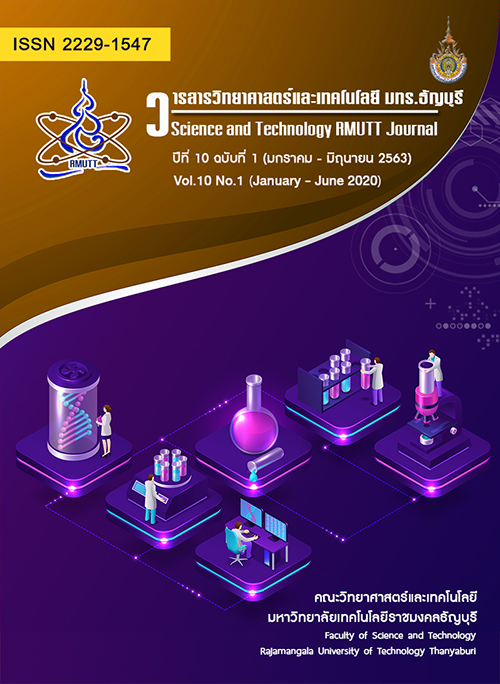Educating terminal velocity in event of free falling of shuttlecock in three meter of height by using smart phone
Main Article Content
Abstract
The objective of this research aims to educate physics quantity and consists of terminal velocity, drag force and drag coefficient of air by construct and develop the free falling of badminton shuttlecock activity in limit of length less than three meter by using smart phone. Experimental solutions have three process, to begin with design and improve experiment by find the least length for free falling and also show terminal velocity in graph. Secondly, try to modify the commercial shuttlecock 10 models by decrease mass and cut off feather to have more air resistance for educated the effect of free fall in 2.8 meter of high. Lastly, analyze the motion in theory and experiment due to air resistance force relate with velocity 2 models including linear equation and quadratic equation and bring the data for numerical analyzed to obtain distance time in the motion and terminal velocity and use relation of air to computed to obtain drag force and drag coefficient.
Experimental results show some of shuttlecock have the terminal velocity by 2.8 meter free falling. Measure physical data of shuttlecock including mass, diameter and front area. The best condition is in the shuttlecock number 3 that have mass about 2.31 gram and feather diameter is 6.64 centimeter which this shuttlecock can show terminal velocity in 3.5 meter per second, drag force is 0.022 Newton and drag coefficient is 0.87.
Article Details
References
พาสนา จุลรัตน์. การศึกษาและการพัฒนาความคิดสร้างสรรค์ของนิสิตระดับปริญญาตรี คณะศึกษาศาสตร์ มหาวิทยาลัยศรีนครินทรวิโรฒ. กรุงเทพฯ: ภาควิชาการแนะแนวและจิตวิทยาการศึกษา มหาวิทยาลัยศรีนครินทรวิโรฒ. 2549.
สถาบันส่งเสริมการสอนวิทยาศาสตร์และเทคโนโลยี. เอกสารการจัดกิจกรรมการเรียนรู้สะเต็มศึกษา. พิมพ์ครั้งที่ 1. โรงพิมพ์ สกสค. ลาดพร้าว. กรุงเทพฯ. 2557.
สุภาวรรณ สวนพลอย วัฒนา รัมมะเอ็ด และ อารยา มุ่งชานาญกิจ. การใช้โปรแกรมวิเคราะห์วิดีโอแทรคเกอร์ช่วยสอนวิชาฟิสิกส์ เรื่องการเคลื่อนที่แบบคาบเพื่อเพิ่มผลการเรียนรู้ของนักเรียนชั้นมัธยมศึกษาปีที่ 4 กรณีศึกษาของโรงเรียนจุฬาภรณราช-วิทยาลัย ปทุมธานี. การประชุมวิชาการระดับชาติมหาวิทยาลัยรังสิต ประจำปี 2558. กรุงเทพฯ ประเทศไทย. 24 เมษายน 2558 ; 1293-1299.
พรทิพย์ ศิริภัทราชัย. STEM Education กับการพัฒนาทักษะในศตวรรษที่ 21. วารสารนักบริหาร. 2556. 33(2) : 49-56.
Dejarnette Nancy K., America’s children: providing early exposure to STEM (science, technology, engineering and math) initiatives. Education. 2012. 133(1) : 77–84.
Lung Ming C., Yi Hsiang P. and Yung-Jen C. A study of shuttlecock’s trajectory in badminton. Journal of Sports Science and Medicine. 2009. 8(4) : 657-662.
Raymond A.S. and John. W.J. Jr. Physics for scientists and engineers with modern physics. 9th ed. Boston, USA. 2014.
Alison J. C. Shuttlecock aerodynamics. Sports Engineering. 1999. 2(2) : 85-96.
Caroline C., Baptiste D., David Q. and Christophe C. The physics of badminton. New Journal of Physics. 2015. 17 : 2-17.
สถาบันส่งเสริมการสอนวิทยาศาสตร์และเทคโนโลยี. หนังสือเรียนรายวิชาเพิ่มเติมฟิสิกส์ เล่ม 1. พิมพ์ครั้งที่ 8. โรงพิมพ์ สกสค. ลาดพร้าว.กรุงเทพฯ. 2554.
Jim N. and Jane N. Buoyancy can can. The physics teacher. 2015. 53(5) : 279-281.
Thornton S.T. and Marion J.B. Classical dynamics of particles and systems. 4th ed. Saunders College Publishing, Harcourt Brace & Company. 2004.
Engelhardt W. Free fall in gravitational theory. Physics Essays. 2017. 30(3) : 294-297
Maxemow S. That's a drag: The effects of drag forces.Undergraduate Journal of Mathematical Modeling: One + Two. 2009. 2(1) : 1-17
Pendrill A.-M., Ekström P., Hansson L., Mars P., Ouattara L. and Ryan U. The equivalence principle comes to school - Falling objects and other middle school investigations. Physics Education. 2014. 49: 425-430.






